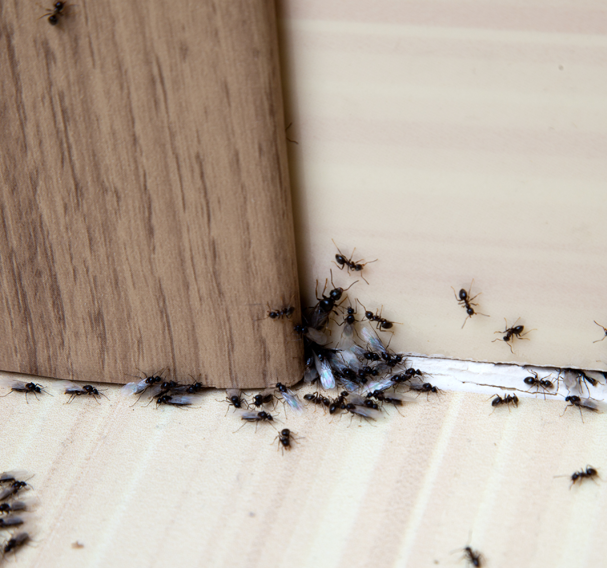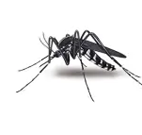Mosquitoes
IDENTIFY
Types of Mosquitoes
What do mosquitoes look like?

Asian Tiger Mosquito
Aedes albopictus

Anopheles Mosquito
How do I get rid of mosquitoes?

What First Choice Exterminating Does
- Locate Where They Come From – A diagram of your property is prepared that indicates actual or potential mosquito development sites.
- Keep Them Out of the House – Providing recommendations to exclude mosquitoes from getting inside the home.
- Eliminate Hiding Spots – Providing recommendations for vegetation management since many species of mosquitoes rest in vegetation around the home during the day.
- Vegetation Treatments – Applying insecticides to vegetation that adult mosquitoes use for sheltered resting sites.
- Water Treatments – Applying insect growth regulators that prevent mosquito development in their water environments.
- Prevent Eggs From Hatching – Applying microbial insecticide products that cause mosquito mortality in their water environments.
Frequently Asked Questions
How did I get mosquitoes?
Mosquitoes in the Home
When mosquitoes find their way inside your home through an open door or window, they usually rest in dark, hidden areas, but will come out at night in search of a blood meal. Homeowners sometimes find mosquitoes under sinks or in closets and laundry rooms.
Mosquitoes in the Yard
Mosquitoes breed in standing water, so properties near ponds, marshes, and depressions that collect rainwater are at risk. Some mosquito species are active at different times of the day, but most emerge just before dusk and are active at night.
How serious are mosquitoes?
Mosquitoes can transmit several dangerous illnesses to humans, including Zika virus. This rare disease affects pregnant women and may lead to birth defects. More common in the U.S. are West Nile virus and several kinds of encephalitis. These mosquito-borne diseases may also have serious side effects. According to a recent CDC statement, the number of illnesses caused by mosquito bites tripled between 2004 and 2016.
What are the signs of a mosquito infestation?
Signs of mosquito activity include the buzzing of the females and their potential bites. People have differing reactions to bites, ranging from mild irritation to intense inflammation and swelling. The presence of standing water can also provide the optimal environment for mosquito reproduction. Nymphs are found in standing water areas such as water bowls for pets, potted plants, bird feeders, and stagnant ponds.
Can pest control help with mosquitoes?
Yes, pest control can help in the removal of mosquitoes with an integrated effort that involves source reduction (finding areas where mosquitoes can reproduce) and the use of chemical products when needed. Mosquito treatment can also help remove other bugs such as spotted lanternflies.
What are the behaviors, diet, and habits of mosquitoes?
Mosquitoes are best known for the habits of the adult females which often feed on blood to help generate their eggs. The lesser-known side is that mosquito adults, males and females, also feed on nectar from flowers. Their immature stages usually are located in standing, preferably stagnant, water. The larvae feed on variety of materials, depending on species.
What Do Mosquito Larvae Eat?
Most consume organic flotsam and tiny aquatic organisms. However, some species are predatory and will consume other mosquitoes. Adult mosquitoes prefer to be most active from dusk until dawn but can become active with sufficient cloud cover or in dark shady areas. They do not prefer to be active in the sunshine since they may desiccate and die.
Mosquitoes or Flies?
Mosquitoes can be confused with flies. Mosquitoes have long legs, and a long proboscis or “nose” that female mosquitoes use to “bite” people and pets to draw blood, needed to lay eggs. Most flies won’t bite and even long-legged flies are usually much smaller than mosquitoes. Mosquitoes are pesky pests and can spread disease such as West Nile Virus, dengue and malaria. More commonly, though, mosquitoes threaten family events more than health.
What is the lifecycle of mosquitoes?
Wormlike larvae, called wigglers because of their wiggling swimming motion, hatch. They feed until ready to molt into pupae. The pupae are called tumblers, again due to their tumbling motion in the water. Adults emerge from the pupae onto the water surface where their exoskeleton hardens.
How do mosquitoes reproduce?
Males have feathery antennae they use to locate females. After mating, females typically seek a blood meal to aid in egg production. She often lays them in standing pools of water, but manmade sources can include bird baths, buckets and even mud puddles. Egg numbers vary from species to species but can be as much as over 100 eggs in a single laying.
Difference between male and female mosquitoes
Most of the differences between male and female mosquitoes are hard to see without using a magnifying glass or a dissecting microscope. However, other differences are fairly easy to see if you know what you’re looking for. Differences between male and female mosquitoes include:
- Females Bite – Male adult mosquitoes do not take blood meals, while the females do. However, a few species of female adult mosquitoes do not imbibe blood at all and feed only on plant nectar and other sugars, just like the males.
- Proboscis – The mosquito’s proboscis that extends out from the mouth area is relatively smooth with the females and somewhat bushy with males.
- Antennae – The hairs or plumes on the mosquitoes’ antenna assist with the ability to hear. The male’s antennae plumes are very “feathery” and large, while the female’s antennae have a smoother, less feathery appearance.
- Size Difference – Generally, male mosquitoes are smaller than females of the same species and live shorter lives than the females.

